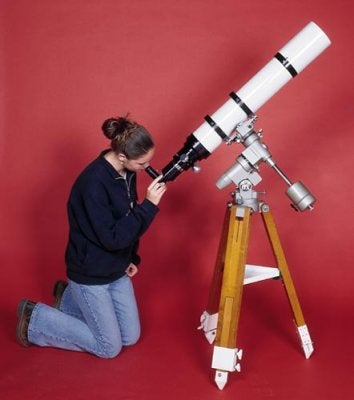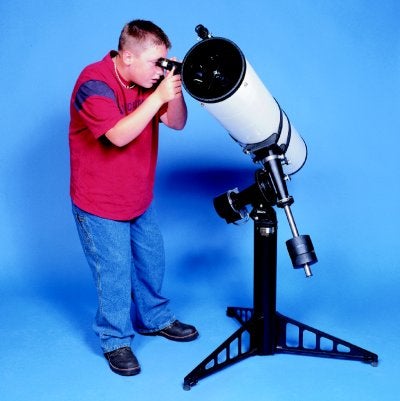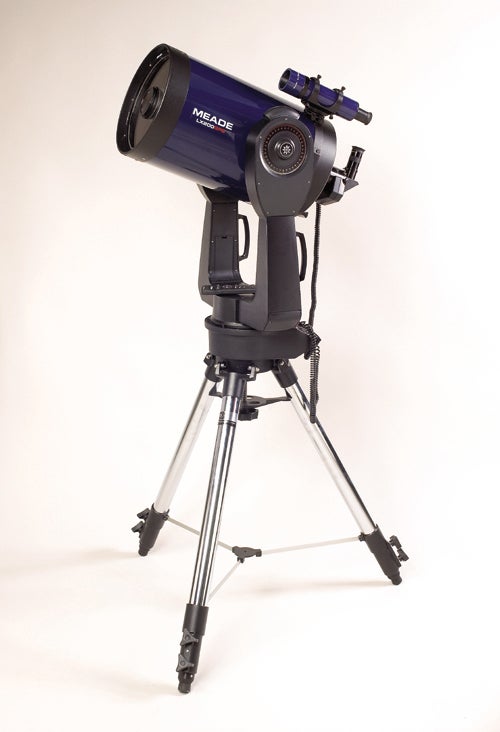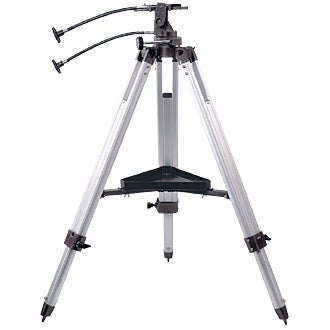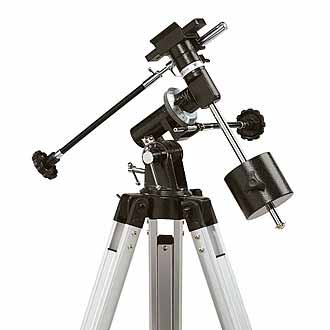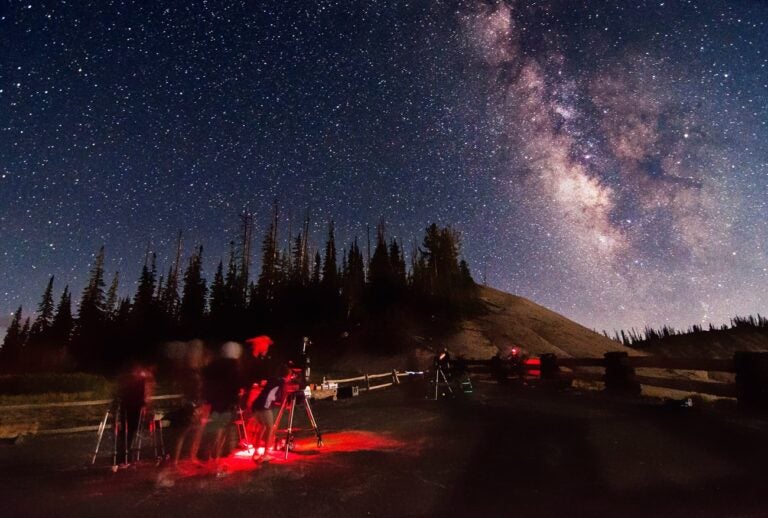Refraction is the bending of light as a result of its passage from one medium (such as air) to another (such as glass). A refracting telescope makes use of this property with a carefully made lens having curved surfaces. As light passes from air to glass and then back to air, its path is bent toward the optical axis of the lens. If the surfaces of the lens are shaped properly, the light is brought to a focus.
The first telescope (of any type) was constructed by the Dutch spectacle maker Hans Lippershey (1570–1619) who, on October 2, 1608, filed a patent application for “an instrument for seeing faraway things as though nearby.” This was a tube — with a convex lens at the front and a concave lens in the rear — that one would look through. The device magnified objects approximately 3 times.
Italian inventor Galileo Galilei (1564–1642) built his own telescopes beginning in 1609. Galileo was the first to use the new device to study celestial objects, and what he saw revolutionized astronomy forever.
The earliest telescopes had poor optical quality. The lenses had various aberrations. One of the problems with early lenses was a defect known as “chromatic aberration.” White light is made of all colors. Unfortunately, the colors, when passed through a simple lens, do not focus at the same point. Blue light is refracted more than red light.
In 1729, Chester Moore Hall (1703–1771) designed a lens that used crown and flint glasses, which gave a relatively color-free image. The word for this type of lens is “achromat” (not color dependent), and it was a monumental achievement.
In the 20th century, achromatic refractors continued to improve. In the 1920s, two problems were tackled: light loss caused by reflections off air-to-glass surfaces, and internal reflections within the lens system. The introduction of oil-spaced objectives solved both problems. The oil eliminated internal reflections and increased the transmission of light. It also smoothed out errors caused by irregularities in the lenses’ surfaces.
In the 1950s, coatings (most notably magnesium fluoride) were developed to reduce light loss and internal reflections without the need for oil. A new type of glass, composed of calcium fluorite, was also invented. (In 1977, the Japanese company Takahashi, Ltd. offered the first fluorite objective in a telescope.)
The first refractor lens labeled “color-free” was a triple lens system offered by Astro-Physics in 1981. Only two “apochromatic” lenses were available at that time, both f/11 magnesium fluoride coated oil-spaced triplets. The smaller was a 150mm and the larger a 200mm. This was the beginning of the new age of apochromatic refractors. Although apochromats are labeled “color-free,” different wavelengths of light do not come to the same focus, but it’s much better than in achromats. Today’s apochromatic objectives have between two and four lens elements. At least one is made with fluorite or ED (extra-low dispersion) glass, which provides even better color correction.
Advantages of refractors
Good-quality achromatic or apochromatic refractors offer some advantages over other telescope designs. The first is that refractors, by default, have a totally clear aperture. No central obstruction causes light to be scattered from brighter to darker areas. Thus, the “contrast” is better in refractors. Refractors often are cited as the premier instruments for planetary and double star observing.
A second advantage of refractors is theirlow maintenance. Lenses do not require recoating like mirrors do. In addition, the optical tube assembly of a refractor generally does not require collimation. The lens is fixed into the tube and usually does not become misaligned, unless it’s exposed to some major trauma.
Disadvantages of refractors
Because the refractor is a closed-tube assembly, it can require a longer amount of time to cool to ambient temperature. Today’s thin-walled aluminum tubes have reduced this period significantly, but cool-down time still should be taken into account.
A second disadvantage, more evident in achromatic refractors, is some chromatic aberration in bright images. This most commonly manifests itself as faint fringes of color around objects like the Moon or Jupiter.
To most amateur astronomers, the primary disadvantage of refractors is cost. This is due to the expense involved in producing a large achromatic or apochromatic lens. The cost ratio between a 150mm apochromatic lens and a high-quality 150mm mirror is at least 10 to 1.
Scottish mathematician James Gregory (1638 – 1675) invented the reflecting telescope and published a description in the book Optica Promota in 1663. Although he’s given credit for the invention, Gregory never actually made the telescope, which was to have used a parabolic and an ellipsoidal mirror.
The first working reflecting telescope was constructed by the great English mathematician Sir Isaac Newton (1642 – 1727) in 1668. It had a spherical mirror with an aperture of 1 inch and a tube length of 6 inches. Not satisfied with his first effort, Newton completed an improved and somewhat larger reflector with an aperture of nearly 2 inches. The first “Newtonian” reflector was presented to the Royal Society in 1671.
A Newtonian reflector contains two mirrors — a large primary mirror at the bottom of the tube and a small, flat secondary mirror near the top of the tube. Light enters the tube, strikes the primary mirror, is reflected to the secondary mirror, and then is reflected again into the eyepiece.
Early reflectors had mirrors made of speculum, an alloy roughly 80 percent copper and 20 percent tin. Once figured and polished, this metal would begin to corrode after only a few months, after which it would need to be polished again.
The Cassegrainian reflector is a type of reflecting telescope with a parabolic primary mirror and a hyperboloidal secondary mirror. Light is reflected through a center hole in the primary mirror, allowing the eyepiece, or a camera, to be mounted at the back end of the tube. The first Cassegrain reflecting telescope was made in 1672 by the French sculptor Sieur Guillaume Cassegrain, about whom little else is known.
In 1835, German chemist Justus Leibig developed a process for depositing a thick layer of silver on glass (1803–1873). This was a major step forward because when the silver tarnished, it could be chemically removed and a new layer redeposited without altering the curvature of the mirror. Apart from tarnishing, silver is not the ideal reflective surface for a telescope mirror. Aluminum, for example, reflects 50 percent more light. In 1932, a young physicist at the California Institute of Technology became the first to coat a mirror with aluminum. Today, all telescope mirrors are coated with aluminum.
Advantages of reflectors
Reflecting telescopes suffer no chromatic aberration.
Mirrors have only one optical surface, whereas an apochromatic lens has between four and eight. Mirrors are therefore much less expensive to produce. Telescopes with apertures of more than 8 inches are, with few exceptions, all reflectors or catadioptrics (see below).
Disadvantages of reflectors
The secondary mirror creates what is called a “central obstruction.” This causes some scattering of light and loss of contrast in the viewed image. To combat this, a few manufacturers have produced so-called planetary Newtonians, which have smaller central obstructions (some as small as 16 percent of the aperture).
All Newtonian reflectors suffer from “coma,” a defect that causes stars near the edge of the field of view to look like a comet. The smaller the focal ratio of the Newtonian scope, the greater the coma. The use of a “coma corrector” for scopes with focal ratios of 5 or shorter increases the usable field of view significantly.
Regarding maintenance, mirrors may require recoating after several years. And reflectors are quite sensitive to being bumped, jostled, or transported. A reflector that is not set up as a permanent instrument should be collimated prior to each observing session. The shorter the focal length, the lower the collimation tolerances for achieving good performance, so accurate collimation becomes even more important.
Large reflectors with thick primary mirrors have a difficult time cooling to ambient temperature. Fans sometimes are employed to aid in the cooling process. Finally, very large Newtonian reflectors require a ladder to reach the eyepiece when objects near the zenith are viewed.
This telescope design was developed jointly by American optician George Willis Ritchey (1864–1945) and French optical designer Henri Chrétien (1879–1956) in the first decade of the 20th century. These two telescope designers found that the lower the amplification factor of the secondary mirror, the flatter the field. The Ritchey-Chrétien system has a secondary mirror that magnifies 2.7x, whereas the Schmidt-Cassegrain design has a 5x secondary. The Ritchey-Chrétien design is coma-free, whereas the Schmidt-Cassegrain is not. Ritchey-Chrétien telescopes have hyperbolic primaries and secondaries that correct for coma; production-type Schmidt-Cassegrains use a spherical primary and secondary and do not correct for coma. Finally, the Ritchey-Chrétien design has two optical surfaces. All Schmidt-Cassegrains have four. Why are Schmidt-Cassegrain telescopes more popular (by far) than Ritchey-Chrétiens? One word: price. A Ritchey-Chrétien telescope is quite costly to produce and, therefore, expensive to buy.
“Catadioptric” means “pertaining” or “due to both reflection and refraction of light.” These scopes also are known as “compound” telescopes and are hybrids that have a mix of refractor and reflector elements in their design.
The first compound telescope was made by German astronomer Bernhard Schmidt (1879–1935) in 1930. The Schmidt telescope had a spherical primary mirror at the back of the telescope and a glass corrector plate in the front of the telescope to remove spherical aberration. This telescope (or “Schmidt camera,” as it is often called) is used for photography by placing photographic film (or a CCD camera) at the prime focus.
The Schmidt camera is the precursor of today’s most popular telescope design, the Schmidt-Cassegrain. This combination of the Cassegrainian telescope with the Schmidt corrector plate was invented in the 1960s. Like the Cassegrain reflector, a secondary mirror bounces light through a hole in the primary mirror to the eyepiece.
The second type of compound telescope was invented by Russian astronomer Dmitri Maksutov (1896–1964) in 1944. The Maksutov telescope is similar to the Schmidt design, but it uses a more spherical corrector lens. This new lens produces a more compact catadioptric telescope. The Maksutov corrector used with a center-hole primary mirror from the Cassegrainian configuration would become known as the Maksutov-Cassegrain, or Mak-Cass.
In the 1950s, Questar Telescopes popularized the Maksutov-Cassegrain. Questars provided views similar to the finest apochromatic refractors of the same aperture, but they were only one-third the physical length of the typical refractor.
In the early 1990s, the Maksutov corrector was coupled to a Newtonian reflector to create the Maksutov-Newtonian. Ceravolo Optical Systems of Ottawa, Canada, introduced the first popular Mak-Newt. In this design, the secondary mirror is flat and imparts no power as do those of the Mak-Cass and Schmidt-Cass telescopes. Also, the optics path is not folded. The effective focal length of the telescope and the overall physical length of Mak-Newt telescopes are about equal to the focal length. Finally, the primary mirror has no hole, so the focuser of a Mak-Newt is positioned as it is on the traditional Newtonian.
Alt-azimuth mounts
An alt-azimuth mount is the simplest type of telescope mount. The word is a combination of altitude and azimuth. Altitude is the distance between the horizon and the zenith. Azimuth is a measurement, in degrees, beginning at the north point of the horizon and proceeding through east. Thus, a telescope on this type of mount will move up and down, and left and right.
Dobsonian mounts
Renowned telescope maker and amateur astronomer John Dobson built his first telescope in 1956. From that point on, he committed himself to helping everyone see the universe. The alt-azimuth mount he invented has revolutionized amateur astronomy. It is a simple dual-pivot mount almost always combined with a Newtonian telescope tube. Just push the telescope up or down to change altitude and push it left or right to change azimuth. It’s a terrific design and easy to build and use.
Driven alt-azimuth mounts
A recent development in alt-azimuth mounts is the driven alt-azimuth mount. With motors attached to both the altitude and azimuth axes of the mount, the telescope can either (1) track an object across the sky once it is placed in the field of view, or (2) interface to a computer to both find and track an object. Quality mounts employing either system are very accurate. Once an object is found, an observer can follow it without continually moving the telescope.
If Earth did not move, an alt-azimuth mount would be all that any of us would ever need. But our planet does spin, and we must deal with it. The second type of mount is called the equatorial mount. It was designed to track the apparent motion of the stars. It does this by aligning one of its axes parallel to Earth’s spin. Please note that there are two types of equatorial mounts — manual and motorized. If you have a choice, select the motorized version.
Digital setting circles
Either alt-azimuth or equatorial mounts may be upgraded with a set of digital setting circles (DSCs), available from many astronomy vendors, for example, Lymax Astronomy.
All commercial DSCs work on alt-azimuth and equatorial mounts. An electronic rotary encoder is placed on each axis, and a small processor performs the transformation from the altitude and azimuth of the mount to the right ascension and declination of the sky.
DSCs appeal to those observers who like to understand the concepts of astronomical coordinate systems but want the processor to do the actual pointing. To set up DSCs, you must center either two or three bright stars (depending on the system) in the field of view. Then, after you enter an object’s designation, you simply move your telescope until the readouts for right ascension and declination are at zero.
Go-to drives
A go-to system is essentially nothing more than a DSC combined with a dual-axis motor driver. As with DSCs, go-to drives require you to center one or two stars for alignment. Most go-to telescopes manufactured today have a large database of objects from which you can select.
Go-to drives have been paired with global positioning system (GPS) electronics and electronic compasses. The result is an almost hands-free setup. The Meade series of GPS telescopes with the Autostar controller is a good example. If you choose the alignment option “Automatic,” the go-to drive first acquires the GPS satellite constellation (as it is called). This allows the drive to figure out the position (longitude, latitude, and elevation) of the telescope. Next, it finds north, then true north, which is offset from magnetic north. Then, it electronically figures out whether the mount is level and compensates in both tip and tilt. After that, the first of two stars is placed into the field of view. You are asked to center the star and press “enter.” This is repeated with a second star. Both stars, by the way, are selected by the telescope’s computer, which already knows whether or not they are above the horizon. That’s it. After three button presses of the control paddle, you’re ready to observe.
Mount stability
We call our instruments “telescopes,” but the phrase “optical tube assembly on a mount” also works. In fact, it points out that half of any “telescope” is the mount. Some would say the mount is the more important part. An unstable mount will render the finest telescope unable to deliver quality images. If the mount is undersized, wind — the bane of most large telescopes — will not be your only enemy. You will experience “bouncing” images even when you are focusing.
The test of a quality mount is sometimes given as the “damp-down factor.” This is the time it takes an image to stabilize (for the vibrations to dampen) after the telescope is moved or refocused. Under no circumstances should the image take more than 5 seconds to damp down. Regarding wind, a spring Texas gale is going to move even the stoutest of mounts. A better test is how your mount responds to a slight breeze.
There is a trade-off to having the “best possible mount,” which would be affixed to a permanent pier sunk into several cubic yards of concrete in an observatory. Most observers want (and need) their telescopes to be portable. An amateur astronomer lucky enough to own a 24-inch Starmaster reflector realizes the “quick-look” type of observing session is pretty much out of the question.
Do your homework
Read everything you can about telescopes. Include manufacturers’ advertisements in your reading, and especially read telescope reviews. Don’t move to the next step until you become familiar with all the terms used to evaluate telescopes. Astronomy magazine is a great resource for both ads and telescope reviews.
Magnifying power?
Avoid any telescope box that touts magnification. Claims of 500x for telescopes are meaningless, and here’s why: All you need to do to change the magnification of a telescope is change the eyepiece. So, if a low-quality, high-power eyepiece is included with the telescope, high (albeit empty) magnifications can be achieved. Normally, you calculate a telescope’s maximum useful magnification by multiplying the size of the lens or mirror in inches by 50. So, a 4-inch telescope can be used with eyepieces that provide up to about 200x. An 8-inch telescope’s highest useful magnification is 400x, and so on. Take it from a long-time observer — you’ll use low magnifications in your telescope far more often than high ones.
Try before you buy
Are you serious about purchasing a quality telescope? If so, try to observe through any model you’re considering. The easiest way to do this is to call or visit a local astronomy club. Find out when they’re hosting a public observing session and attend it. Observe through as many telescopes as you can, and ask as many questions as you can think of. Ask about setup time, maintenance, accessories, and cost. If you can’t find an astronomy club nearby, call or visit a local planetarium. The staff there will be aware of any astronomy clubs in your area.
Seek out a reputable dealer
Telescope dealers that have been in business a while have sold scopes to all types of buyers. Long-time dealers will ask you questions to determine your level of expertise and your interests. A good dealer will not try to sell you more telescope than you need. For this reason, I cannot suggest that you purchase a telescope from a department store or catalog showroom.
Buy a gigantic telescope
OK, I’m joking here, but I want to make a point. With telescopes, two seemingly contradictory rules apply: The bigger the telescope, the better. The smaller the telescope, the more often you’ll use it. The only time the second rule doesn’t apply is if you build a nearby observatory. A 10-inch telescope will outperform an 8-inch, which will outperform a 6-inch, etc. But you’re less likely to fear setting up a small refractor on a simple tripod than a large Newtonian reflector on a heavy mount.

